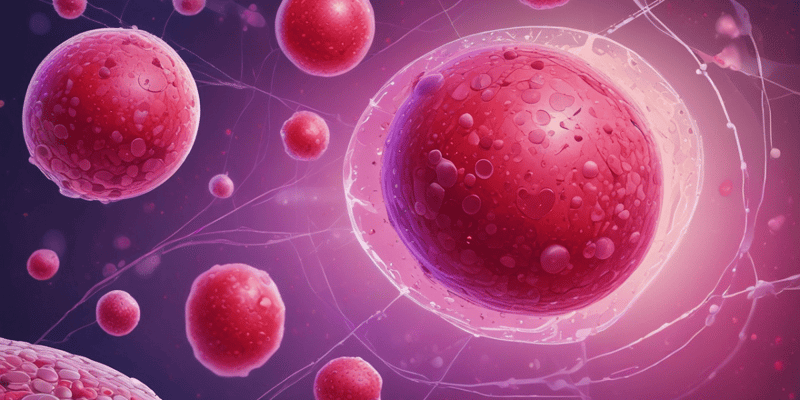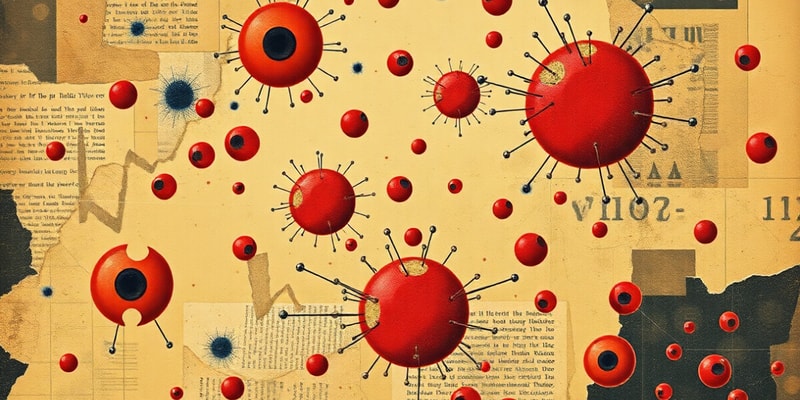Podcast
Questions and Answers
What is the characteristic of Ewingii species?
What is the characteristic of Ewingii species?
What is the primary component of the inclusions in May-Hegglin anomaly?
What is the primary component of the inclusions in May-Hegglin anomaly?
What is the characteristic of giant platelets in certain disorders?
What is the characteristic of giant platelets in certain disorders?
What is the primary anomaly in Chédiak-Higashi syndrome?
What is the primary anomaly in Chédiak-Higashi syndrome?
Signup and view all the answers
What is the characteristic of neutrophils in Chédiak-Higashi syndrome?
What is the characteristic of neutrophils in Chédiak-Higashi syndrome?
Signup and view all the answers
What is the characteristic of Alder-Reilly anomaly?
What is the characteristic of Alder-Reilly anomaly?
Signup and view all the answers
What is the composition of the dense granules in Alder-Reilly anomaly?
What is the composition of the dense granules in Alder-Reilly anomaly?
Signup and view all the answers
What is the effect of Alder-Reilly anomaly on leukocyte function?
What is the effect of Alder-Reilly anomaly on leukocyte function?
Signup and view all the answers
What is the characteristic of granulopoietic alterations?
What is the characteristic of granulopoietic alterations?
Signup and view all the answers
What is the characteristic of defective PMNs in Chédiak-Higashi syndrome?
What is the characteristic of defective PMNs in Chédiak-Higashi syndrome?
Signup and view all the answers
Study Notes
Ehrlichia and Neutrophils
- E. ewingii is the sole Ehrlichia species that infects neutrophils.
- Toxic vacuolization refers to vacuole formation in neutrophil cytoplasm, indicative of severe infections or inflammation.
Morphological Abnormalities of Granulocytes
- Abnormalities in mature granulocytes are classified into nuclear and cytoplasmic.
Nuclear Abnormalities
- Hypersegmentation: Neutrophils with more than five nuclear lobes, linked to megaloblastic anemia (often due to B12 or folic acid deficiency).
- Pelger-Huët Anomaly (PHA): A benign genetic defect characterized by hyposegmented neutrophils (fewer than three lobes) with heavy chromatin clumping; function usually normal.
- Pyknotic Nucleus: Condensed neutrophil nuclei indicating apoptosis; present in inflammatory and neoplastic conditions.
Cytoplasmic Abnormalities
- Toxic Granulation: Dark granulation, represents metabolic toxicity; associated with severe infections, burns, or drug reactions.
- Toxic Vacuolization: Vacuoles in neutrophils’ cytoplasm, indicating response to infections; contents include water and cell waste.
- Döhle Bodies: Blue-grey structures indicating ribosome aggregates, seen with infections, burns, or certain drugs.
- Ehrlichiosis: Ehrlichia bacteria invade mononuclear phagocytes, forming bacterial microcolonies in vacuoles.
Leukocyte Alkaline Phosphatase (LAP)
- Normal LAP score ranges from ~18 to 185; high scores indicate various conditions like leukemoid reactions, and low scores may suggest chronic myeloid leukemia or aplastic anemia.
- Elevations associated with infections, polycythemia vera, and certain leukemias; decreases noted in granulocytopenia conditions.
Leukocytosis
- Eosinophilia: Increased eosinophils observed in allergic reactions, non-parasitic infections, and certain leukemias.
- Basophilia: Exists if basophils exceed 0.075 x 10^9/L; associated with overactive thyroid, allergies, and conditions like chronic myelogenous leukemia.
- Monocytosis: Increased monocytes noted in chronic infections, tuberculosis, and inflammatory diseases.
Leukocytopenia and Granulocytopenia
- Leukocytopenia is the reduction of leukocytes; mainly caused by decreased segmented neutrophils.
- Granulocytopenia indicates low granulocytes, leading to increased susceptibility to infections.
Inherited Functional Abnormalities
- May-Hegglin Anomaly: Characterized by Döhle body-like inclusions, thrombocytopenia, and giant platelets; inherited condition affecting myosin heavy chain production.
- Chédiak-Higashi Syndrome: Autosomal recessive disorder resulting in immune deficiency and platelet dysfunction, with large granules in leukocytes.
- Alder-Reilly Anomaly: Found in mucopolysaccharidoses, includes purple-red granules in leukocytes but does not affect their function.
Qualitative Leukocyte Disorders
- Disorders reflect defects in locomotion, adhesion, chemotaxis, and bacterial killing capabilities of leukocytes.
Studying That Suits You
Use AI to generate personalized quizzes and flashcards to suit your learning preferences.
Description
Test your knowledge of neutrophil abnormalities, including toxic vacuolization and hypersegmentation, which can be associated with megaloblastic anemia and infections. Identify the different types of nuclear abnormalities and their causes. Improve your understanding of hematological disorders.




